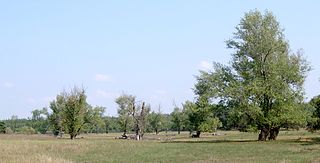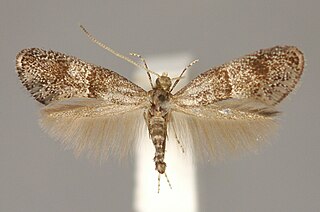
Populus nigra, the black poplar, is a species of cottonwood poplar, the type species of section Aigeiros of the genus Populus, native to Europe, southwest and central Asia, and northwest Africa.

A leaf miner is any one of numerous species of insects in which the larval stage lives in, and eats, the leaf tissue of plants. The vast majority of leaf-mining insects are moths (Lepidoptera), sawflies, and flies (Diptera). Some beetles also exhibit this behavior.

Douglasiidae is a small Lepidopteran family including around 28 species of micromoth whose adults are collectively called Douglas moths. The largest genus in the family is Tinagma. They are primarily found in the Palearctic and Nearctic realms. The adults have a 6 to 15 mm wingspan, with a reduced hindwing venation and long fringes. The larvae are leaf miners or borers, primarily in stems and petioles, belonging to Boraginaceae, Labiatae, and Rosaceae.

Afghanica, not to be confused with Afghan Kush, is a hybrid strain of cannabis. Its origination plants were Afghani #1 and so-called "Original" Skunk. Growing up to 1.83 m (6 ft.) tall, it is short and stocky with broad leaves a lush canopy, and dense buds as well. The plant matures over the summer and is ready for harvest in mid-autumn.

Tinagma balteolella is a moth in the Douglasiidae family. It is found in Great Britain, France, Belgium, the Netherlands, Germany, Switzerland, Austria, Italy, Spain, the Czech Republic, Slovakia, Croatia, Hungary, Romania, Poland, Lithuania and Ukraine. It is also found in Morocco and Jordan.

Tinagma is a genus of moths in the Douglasiidae family. It is primarily found in the Palearctic and Nearctic realms
Apatophysis is a genus of longhorn beetles in the subfamily Dorcasominae.

Tinagma anchusella is a moth in the Douglasiidae family. It is found in Denmark, Germany, Austria, Poland, Bulgaria, Greece, Estonia, Latvia, Sweden, Ukraine and on Cyprus. It is also found in Turkey, Jordan and the Caucasus region.
Tinagma klimeschi is a moth in the family Douglasiidae. It is found in Israel, Egypt and on Rhodes and Cyprus.
Tinagma bledella is a moth in the family Douglasiidae. It is found in Algeria.
Tinagma grisecens is a moth in the Douglasiidae family. It is found in Palestine, Syria and Asia Minor.
Tinagma obscurofasciella is a moth in the family Douglasiidae. It is found in North America, where it has been recorded from Kentucky, Maine, Michigan and Minnesota.

Klimeschia is a genus of moths in the family Douglasiidae. It is found in the Palearctic realm
Klimeschia lutumella is a moth in the Douglasiidae family. It was described by Hans Georg Amsel in 1938. It is found in Israel.
Klimeschia paghmanella is a moth in the family Douglasiidae. It was described by Reinhard Gaedike in 1974. It is found in Afghanistan.
Klimeschia thymetella is a moth in the Douglasiidae family. It was described by Staudinger in 1859. It is found in Portugal and Spain.

Klimeschia transversella is a moth in the family Douglasiidae. It was described by Zeller in 1839. It is found in Spain, Portugal, Italy, France, Belgium, Germany, Poland, Denmark, Austria, the Czech Republic, Slovakia, Croatia, Bosnia and Herzegovina, Hungary, Romania, North Macedonia, Greece, Finland, Sweden, Belarus, the Baltic region and Russia.
Klimeschia vibratoriella is a moth in the family Douglasiidae. It was described by Josef Johann Mann in 1862. It is found in Turkey.

Ochromolopis is a genus of moths in the family Epermeniidae described by Jacob Hübner in 1824.
Iris afghanica is a plant species in the genus Iris, it is also in the subgenus Iris and in the section Regelia. It is a rhizomatous perennial, from Afghanistan, with thin bluish-green leaves and creamy yellow or white flowers, that are veined with purple-brown. It has yellow-green or purple beards. Although, in the wild, it can vary in colour and size. It is cultivated as an ornamental plant in temperate regions.







